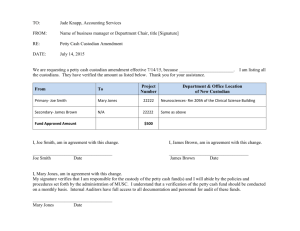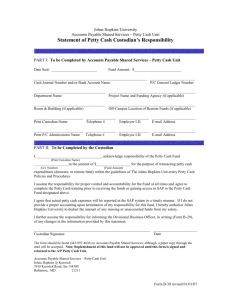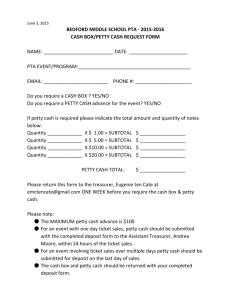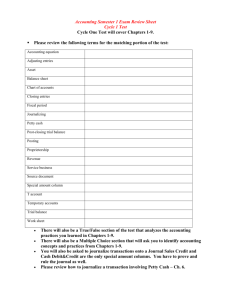Petty Cash Audit - University of Pennsylvania
advertisement
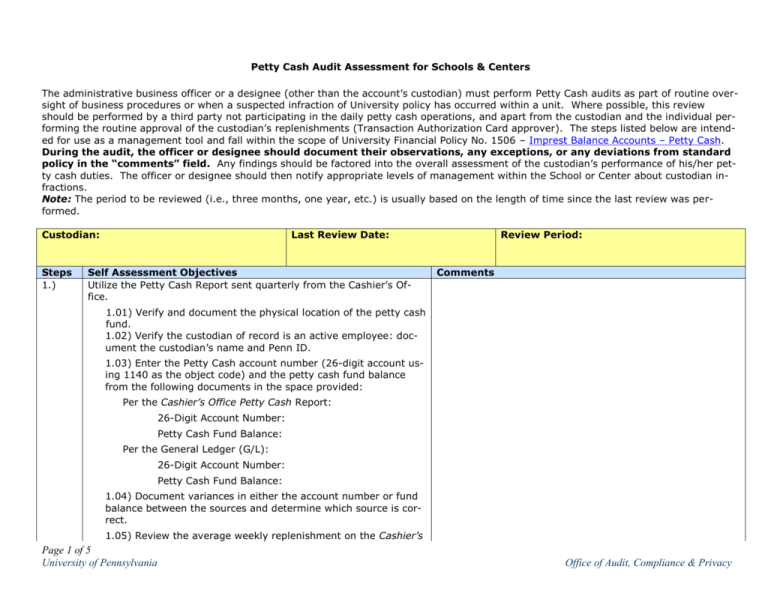
Petty Cash Audit Assessment for Schools & Centers The administrative business officer or a designee (other than the account’s custodian) must perform Petty Cash audits as part of routine oversight of business procedures or when a suspected infraction of University policy has occurred within a unit. Where possible, this review should be performed by a third party not participating in the daily petty cash operations, and apart from the custodian and the individual performing the routine approval of the custodian’s replenishments (Transaction Authorization Card approver). The steps listed below are intended for use as a management tool and fall within the scope of University Financial Policy No. 1506 – Imprest Balance Accounts – Petty Cash. During the audit, the officer or designee should document their observations, any exceptions, or any deviations from standard policy in the “comments” field. Any findings should be factored into the overall assessment of the custodian’s performance of his/her petty cash duties. The officer or designee should then notify appropriate levels of management within the School or Center about custodian infractions. Note: The period to be reviewed (i.e., three months, one year, etc.) is usually based on the length of time since the last review was performed. Custodian: Steps 1.) Last Review Date: Self Assessment Objectives Utilize the Petty Cash Report sent quarterly from the Cashier’s Office. Review Period: Comments 1.01) Verify and document the physical location of the petty cash fund. 1.02) Verify the custodian of record is an active employee: document the custodian’s name and Penn ID. 1.03) Enter the Petty Cash account number (26-digit account using 1140 as the object code) and the petty cash fund balance from the following documents in the space provided: Per the Cashier’s Office Petty Cash Report: 26-Digit Account Number: Petty Cash Fund Balance: Per the General Ledger (G/L): 26-Digit Account Number: Petty Cash Fund Balance: 1.04) Document variances in either the account number or fund balance between the sources and determine which source is correct. 1.05) Review the average weekly replenishment on the Cashier’s Page 1 of 5 University of Pennsylvania Office of Audit, Compliance & Privacy Custodian: Steps Last Review Date: Self Assessment Objectives Office Petty Cash Report. Calculate the average bi-weekly replenishment (average weekly replenishment multiplied by 2). Verify the average bi-weekly replenishment is greater than or equal to the petty cash fund balance. If the bi-weekly replenishment is less than the fund balance, it falls outside the policy range (the fund balance should be limited to two weeks expenditures). Document the balance is within policy range; or document the corrective action (i.e., decrease fund). Review Period: Comments Average Bi-Weekly Replenishment: PC Fund Balance: Within Policy Range: Yes or No 1.06) Document the frequency of reimbursements. The fund should be replenished at least monthly. If the Petty Cash fund is not replenished monthly: note the exception and either justify why the balance is appropriate or document the corrective action (i.e., decrease amount of fund, close fund). 2.) 3.) Access to the petty cash fund should be limited to the official custodian of record. Describe how access to the petty cash fund is restricted and note any absence of security measures. Perform the following tests on activity within the petty cash lock box (cash and vouchers not yet replenished on hand with the custodian): 3.01) In the presence of the custodian, count the petty cash in the box and subtotal the Petty Cash Vouchers. Document the totals using the Petty Cash Count Sheet. If the sum does not equal the Petty Cash fund balance, create an exception and explain the variance. 3.02) Describe the custodian’s filing system for retaining all supporting documentation for disbursements. Check each of the disbursements for the following: Required documentation (i.e., Voucher, Form C-2) Signature of Recipient (acquired at time of disbursement) Third Party Supplier Receipt/Invoice Page 2 of 5 University of Pennsylvania Office of Audit, Compliance & Privacy Custodian: Steps Last Review Date: Self Assessment Objectives Description of item or service (business purpose) Proper Approvals Appropriate account number charged Review Period: Comments Document any exceptions for missing documentation or instances of incorrect charges. 3.03) Compare the disbursements to the BEN Financials Commodity Matrix. Document whether the disbursements are proper, and note if any charges are for items for which petty cash is prohibited as payment. Document any instances of improper disbursements/usage (e.g. expenditures > $50, alcohol, sales tax, wages, check cashing, change fund, loans, salary advances, etc.) 4.) Review two (2) random, previously replenished Request for Reimbursement of Petty Cash Fund forms selected from the Cashier’s Office Petty Cash Report: Document selected Reimbursement of Petty Cash Fund forms’: A. 1. Replenishment Date: 2. Dollar Amount: B. 1. Replenishment Date: 2. Dollar Amount: 4.01) Verify the custodian keeps copies on file of submitted Request for Reimbursement of Petty Cash Fund forms. Verify that the dates match those on the Cashier’s report. Document any exceptions. 4.02) Manually sum the individual Petty Cash Vouchers and verify the total amount equals the total on the Request for Reimbursement of Petty Cash Fund form. Document that you have completed this test and if necessary note any exceptions (i.e., instances of missing documentation or incorrect amounts). 4.03) Verify and document that each Petty Cash Voucher is supported by a third-party (supplier) receipt/invoice. Verify and document the amount reimbursed to the requestor is correct and does not include Pennsylvania sales tax. Document any exceptions (i.e., instances of missing documentation or incorrect Page 3 of 5 University of Pennsylvania Office of Audit, Compliance & Privacy Custodian: Steps Last Review Date: Self Assessment Objectives charges). Review Period: Comments 4.04) For human subject payments: document the custodian’s process for collecting the W-9 form (or the Foreign National Information form, if applicable). Note whether the custodian retains copies of the W-9 form. Document whether a C-2 Human Subjects Voucher was completed for each disbursement (any receipts for out-of-pocket expenses should be attached to the C-2 voucher). Document any exceptions. For further information see Financial Policy No. 2319.1 –Payment of Human Subject Fees. 4.05) Document whether or not charges are normally expensed to object codes in the 5xxx (expense) series. If object codes in the 1xxx (asset) or liability (2xxx) series are used, explain why the charges are correct based on the business nature of the transaction. Note any misuse of object codes. 4.06) Ensure the total amount requested on the Request for Reimbursement of Petty Cash Fund form does not exceed the total amount of the petty cash fund. Note any instances where the reimbursement amount exceeds the fund balance. 4.07) Verify the petty cash custodian reconciles the petty cash fund at every replenishment and fills in the Request for Reimbursement of Petty Cash Fund form correctly. Document whether or not the custodian counts the cash-on-hand at every replenishment to verify the total dollar amount. Document any observed weaknesses in the custodian’s replenishment process. 4.08) Ensure an appropriate Transaction Authorization Card (TAC) approver reviews, signs, and embosses the Request for Reimbursement of Petty Cash Fund form. Document whether or not each form has the appropriate TAC approvals. Document the TAC approver’s process for reviewing and approving replenishments to ensure the approver understands their roles and responsibilities. Document observations and note any weaknesses in this process. 5.) Assess the risk of errors and irregularities going undetected: 5.01) Document adequate segregation of duties are satisfied Page 4 of 5 University of Pennsylvania Office of Audit, Compliance & Privacy Custodian: Steps Last Review Date: Self Assessment Objectives (i.e., the custodian and the individual responsible for review of supporting documents and authorizing replenishment via his/her Transaction Authorization Card are two separate people). Note any overlapping duties. Review Period: Comments 5.02) Ensure no individual besides the custodian disburses cash and reconciles the fund. Document whether or not the custodian understands their role regarding cash disbursements and fund reconciliations, including that no other individual may handle these functions (e.g., the custodian’s supervisor, or business administrator). Document any exceptions (i.e., petty cash fund is split among multiple individuals, individuals other that the custodian are disbursing cash, etc). 5.03) Document the current roles and responsibilities of the petty cash custodian, as well as those of the TAC approver. Determine if the roles have changed since the last review took place and ensure that the petty cash fund responsibilities assigned to the custodian are still appropriate. 6.) Document whether or not checks are performed on the petty cash fund’s default account number (object code 1140) for stray or inappropriate transactions. Document who performs these checks. Create an exception if checks are not performed on the account number. 7.) Document that the results of the petty cash review are properly communicated to the appropriate levels of management within the school or center. 8.) Review the University imposed sanctions as per University Financial Policy 1506 for careless or blatant misuse of the petty cash fund with the custodian. Document the sanctions were reviewed with the custodian. Completed By Page 5 of 5 University of Pennsylvania Date Office of Audit, Compliance & Privacy
